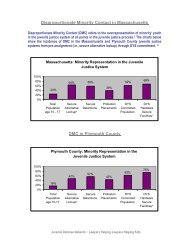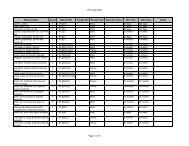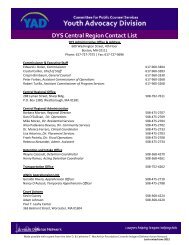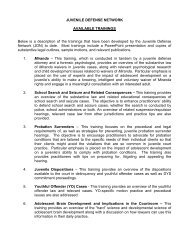States rethink 'adult time for adult crime' - the Youth Advocacy Division
States rethink 'adult time for adult crime' - the Youth Advocacy Division
States rethink 'adult time for adult crime' - the Youth Advocacy Division
You also want an ePaper? Increase the reach of your titles
YUMPU automatically turns print PDFs into web optimized ePapers that Google loves.
make us uniquely human are <strong>the</strong> latest to become fully integrated into <strong>the</strong> workings of<br />
<strong>the</strong> developing brain.<br />
University of Chicago researcher Peter Huttenlocher uncovered ano<strong>the</strong>r<br />
neurodevelopmental phenomenon apparently taking place during adolescence:<br />
pruning. According to <strong>the</strong> pruning hypo<strong>the</strong>sis, neurons and <strong>the</strong>ir connections that have<br />
not been consistently used during childhood “shrivel off” and are eliminated at some<br />
point during adolescence, <strong>the</strong>reby allowing <strong>for</strong> greater efficiency of <strong>the</strong> remaining neural<br />
systems.<br />
Postmortem tissue studies have contributed important insights into understanding<br />
brain maturation, but <strong>the</strong>y have serious limitations, including tissue availability and <strong>the</strong><br />
inability to trace developmental changes in <strong>the</strong> same individual.<br />
These difficulties are circumvented by a set of novel techniques—developed in <strong>the</strong> 1970s<br />
and fully implemented by <strong>the</strong> 1990s—that can be generally referred to as structural<br />
imaging. These methods permit visualization and volumetric measurement of brain<br />
structure in living people without any risk to <strong>the</strong> subjects. The method that has become<br />
state-of-<strong>the</strong>-art <strong>for</strong> <strong>the</strong>se studies is based on magnetic resonance imaging (MRI)<br />
procedures. MRI has provided data on <strong>the</strong> composition of three brain components, or<br />
compartments: gray matter—nerve tissue responsible <strong>for</strong> in<strong>for</strong>mation processing; white<br />
matter—nerve tissue responsible <strong>for</strong> in<strong>for</strong>mation transmission; and cerebrospinal fluid.<br />
This division of <strong>the</strong> brain into <strong>the</strong>se compartments is termed segmentation.<br />
In one of <strong>the</strong> first studies examining segmented MRI in children and <strong>adult</strong>s, researchers<br />
Terry Jernigan and Paula Tallal from <strong>the</strong> University of Cali<strong>for</strong>nia have documented <strong>the</strong><br />
pruning process. They found that children had higher volumes of gray matter than<br />
<strong>adult</strong>s, indicating loss of gray matter during adolescence. In ano<strong>the</strong>r study Stan<strong>for</strong>d<br />
researchers Adolph Pfefferbaum and Calvin Lim demonstrated a clearly different<br />
developmental course <strong>for</strong> gray matter and white matter: The <strong>for</strong>mer declined steadily<br />
during adolescence while <strong>the</strong> latter increased in volume until about 20-22 years of age.<br />
A subsequent NIH study led by Judith Rappoport pinpointed <strong>the</strong> greatest delay in<br />
myelination <strong>for</strong> <strong>the</strong> brain’s fronto-temporal pathways.<br />
In <strong>the</strong> only study to date that examined segmented MRI volumes from a prospective<br />
sample of 28 healthy children aged one month to 10 years, as well as a small <strong>adult</strong><br />
sample, researchers from Penn and Toyama University in Japan applied segmentation<br />
procedures developed by <strong>the</strong> Penn group. This, actually, was <strong>the</strong> very study that<br />
prompted me to write a review of <strong>the</strong> literature, which I used <strong>for</strong> Mr. Bookman’s<br />
request. We found that while gray matter volume peaked at about two years of age, <strong>the</strong><br />
volume of white matter, which indicates brain maturation, continued to increase into<br />
<strong>adult</strong>hood. Fur<strong>the</strong>rmore, we found that <strong>the</strong> frontal lobe showed <strong>the</strong> greatest<br />
maturational lag and its myelination is unlikely to be completed be<strong>for</strong>e young<br />
<strong>adult</strong>hood.<br />
Most recently, investigators at UCLA’s brain imaging center analyzed MRI scans of 13<br />
healthy children over a period of eight to 10 years. They concluded that brain areas in
















